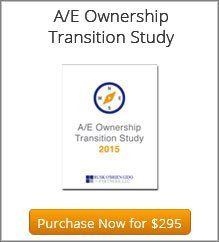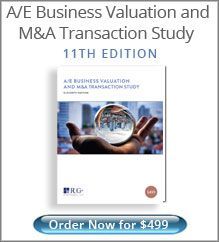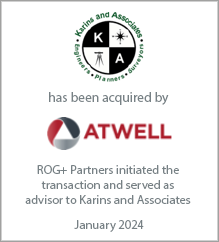Michael S. O'Brien is a principal in the Washington, DC office of Rusk O'Brien Gido + Partners. He specializes in corporate financial advisory services including business valuation, fairness and solvency opinions, mergers and acquisitions, internal ownership transition consulting, ESOPs, and strategic planning. Michael has consulted hundreds of architecture, engineering, environmental and construction companies across the U.S. and abroad.
Deferred Compensation – Know The Risk
Deferred Compensation – Know The Risk
September 20, 2011
Two decades ago a business trend caught my attention that was a foreshadowing of things to come. I was doing a considerable amount of advisory work with companies that operated in the steel industry as it was on the precipice of the pension benefit meltdown. Years later, when my former firm served as an advisor to the UAL ESOP transaction, I saw it again – the airline industry was experiencing a meltdown of legacy costs. Over the past decade, I saw the effects of pension obligations and how they impacted the financial stability of automobile manufacturers in the U.S. For every car built in Detroit, there were significant legacy costs due to ongoing pension obligations. Today, we are seeing the problems of pension obligations, and how they’re influencing the workforce. In fact, Governor Christie (NJ) has expressed the idea of converting public pensions from defined benefits to defined contributions. But what do pension benefits have to do with deferred compensation?
First, I’d like to discuss the economics of pensions and how they can affect a company’s future financial condition. Then, we’ll take a closer look at how the same can be attributed to deferred compensation plans. Companies that sponsor employee pension benefits generally do so because they believe that such benefits reduce the cost of goods and services that are tied to the overall compensation of employees. By deferring a portion of an employee’s compensation for the future, the current costs are reduced by the present value of the future liability (which is realized at the time of payment). As an example, if an employee is making $75,000, and his company promises to pay him 50% of his income upon retirement, he would effectively be receiving $37,500. Depending on the age of this employee, the actual cash outflow might not occur for decades. Furthermore, if the company were to make a contribution to this employee’s retirement plan, the investment wouldn’t be $37,500, but significantly lower. Why? Because of their expectation that initial investment and future investments will grow overtime to meet the employee’s future retirement obligations.
Trying to capture the value of the future pension obligation is an exercise in futility, because there are too many variables that impact its present value. Life expectancy after retirement can have the greatest influence on value – in other words, the longer a person lives, the greater the liability becomes. This life expectancy assumption is what is killing Social Security and Medicare. When Social Security was first implemented, the number of years the typical recipient received the pension was less than one year. Now, people are living decades past their first benefit check. Secondly, future market conditions impact expected returns, which in turn impacts the value of the plan assets. When I began developing my own personal model for retirement a decade ago, I made certain basic assumptions of my expected future returns; one primary assumption was that I could realize a 7% annual return on investment while in retirement. If I were beginning my retirement modeling in today’s climate, I believe that what I had originally assumed as my return would be flawed. In 2001, 30-year treasury notes were yielding 5.5% – today, many would be glad for 3.5%.
So, how does this compare to deferred compensation plans? Companies sponsor deferred compensation plans as part of a total compensation package for their employees – the most common plan being the 401(k). However, some firms will implement other forms of deferred compensation for a variety of reasons, the least of which includes wanting to reduce the threat of flight risk by the most valued and productive employees. Typically, these compensation plans are agreements between the employees and the company in which the company promises to pay, in the future, an amount predetermined by a formula – much like a pension. Doing so creates a liability that negatively affects the equity value of the sponsoring company, because the promise to pay the liability in the future is recorded on the balance sheet. However, the company is not required to set aside funds to satisfy this obligation. In fact, firms must exercise care when establishing a deferred plan, because if there is any guarantee of the delivery of deferred compensation, then the plan’s beneficiary has obtained constructive receipt of the deferred compensation and must recognize taxes immediately, even though he did not actually receive the funds. On the other hand, the company is able to deduct the amount of compensation that is being deferred in the year it was incurred. Why would firms do this? In addition to golden handcuffs, firms often use deferred compensation as a tool to reduce the value of equity in the company. As the value of the liability increases over time, the growth of value of the sponsoring company is limited. This means that acquiring shares by future employees becomes more affordable, and therefore will increase the likelihood of a successful ownership transition in the future.
So, why not implement deferred compensation plans? In short, whether you pay for a high value stock with no deferred compensation today, or a low value stock with deferred compensation in the future, the share purchaser will still pay for the high value. With a deferred compensation plan, a company is only delaying the inevitable, as the payment will ultimately come from company funds. Simply put, less cash means less bonuses and profit distributions.
At the crux of any promise, whether that promise be deferred compensation, bank debt, or shareholder notes, is that the obligation created today will require payments that rely on future cash flow. It may be possible to reasonably predict future payment obligations, but it’s a much more difficult task to predict future cash flow. My colleague, Ian Rusk, discussed the risk of using aggressive leverage in our August 2011 ROG + Perspective – deferred compensation is just another form of leverage that creates a strong key employee retention plan and helps manage ownership transition planning.
If Governor Christie (NJ) is proposing to convert public pensions from defined benefit plans to defined contribution plans, it won’t happen soon, but I wouldn’t be surprised if we begin seeing more public plans move in this direction. Following suit will be more companies coming up with creative ways of mitigating the flight risk of key employees, balanced with the need for feasible stock ownership plans.
First, I’d like to discuss the economics of pensions and how they can affect a company’s future financial condition. Then, we’ll take a closer look at how the same can be attributed to deferred compensation plans. Companies that sponsor employee pension benefits generally do so because they believe that such benefits reduce the cost of goods and services that are tied to the overall compensation of employees. By deferring a portion of an employee’s compensation for the future, the current costs are reduced by the present value of the future liability (which is realized at the time of payment). As an example, if an employee is making $75,000, and his company promises to pay him 50% of his income upon retirement, he would effectively be receiving $37,500. Depending on the age of this employee, the actual cash outflow might not occur for decades. Furthermore, if the company were to make a contribution to this employee’s retirement plan, the investment wouldn’t be $37,500, but significantly lower. Why? Because of their expectation that initial investment and future investments will grow overtime to meet the employee’s future retirement obligations.
Trying to capture the value of the future pension obligation is an exercise in futility, because there are too many variables that impact its present value. Life expectancy after retirement can have the greatest influence on value – in other words, the longer a person lives, the greater the liability becomes. This life expectancy assumption is what is killing Social Security and Medicare. When Social Security was first implemented, the number of years the typical recipient received the pension was less than one year. Now, people are living decades past their first benefit check. Secondly, future market conditions impact expected returns, which in turn impacts the value of the plan assets. When I began developing my own personal model for retirement a decade ago, I made certain basic assumptions of my expected future returns; one primary assumption was that I could realize a 7% annual return on investment while in retirement. If I were beginning my retirement modeling in today’s climate, I believe that what I had originally assumed as my return would be flawed. In 2001, 30-year treasury notes were yielding 5.5% – today, many would be glad for 3.5%.
So, how does this compare to deferred compensation plans? Companies sponsor deferred compensation plans as part of a total compensation package for their employees – the most common plan being the 401(k). However, some firms will implement other forms of deferred compensation for a variety of reasons, the least of which includes wanting to reduce the threat of flight risk by the most valued and productive employees. Typically, these compensation plans are agreements between the employees and the company in which the company promises to pay, in the future, an amount predetermined by a formula – much like a pension. Doing so creates a liability that negatively affects the equity value of the sponsoring company, because the promise to pay the liability in the future is recorded on the balance sheet. However, the company is not required to set aside funds to satisfy this obligation. In fact, firms must exercise care when establishing a deferred plan, because if there is any guarantee of the delivery of deferred compensation, then the plan’s beneficiary has obtained constructive receipt of the deferred compensation and must recognize taxes immediately, even though he did not actually receive the funds. On the other hand, the company is able to deduct the amount of compensation that is being deferred in the year it was incurred. Why would firms do this? In addition to golden handcuffs, firms often use deferred compensation as a tool to reduce the value of equity in the company. As the value of the liability increases over time, the growth of value of the sponsoring company is limited. This means that acquiring shares by future employees becomes more affordable, and therefore will increase the likelihood of a successful ownership transition in the future.
So, why not implement deferred compensation plans? In short, whether you pay for a high value stock with no deferred compensation today, or a low value stock with deferred compensation in the future, the share purchaser will still pay for the high value. With a deferred compensation plan, a company is only delaying the inevitable, as the payment will ultimately come from company funds. Simply put, less cash means less bonuses and profit distributions.
At the crux of any promise, whether that promise be deferred compensation, bank debt, or shareholder notes, is that the obligation created today will require payments that rely on future cash flow. It may be possible to reasonably predict future payment obligations, but it’s a much more difficult task to predict future cash flow. My colleague, Ian Rusk, discussed the risk of using aggressive leverage in our August 2011 ROG + Perspective – deferred compensation is just another form of leverage that creates a strong key employee retention plan and helps manage ownership transition planning.
If Governor Christie (NJ) is proposing to convert public pensions from defined benefit plans to defined contribution plans, it won’t happen soon, but I wouldn’t be surprised if we begin seeing more public plans move in this direction. Following suit will be more companies coming up with creative ways of mitigating the flight risk of key employees, balanced with the need for feasible stock ownership plans.
Latest Perspective
Perfecting the A/E Exit Strategy – Five Key Factors
An enormous A/E generation that kicked off their careers in the 1980s and subsequently started firms or became owners in the 1990s ...
© 2024
Rusk O'Brien Gido + Partners, LLC
Financial Experts for Architects, Engineers, and Environmental Consulting Firms









